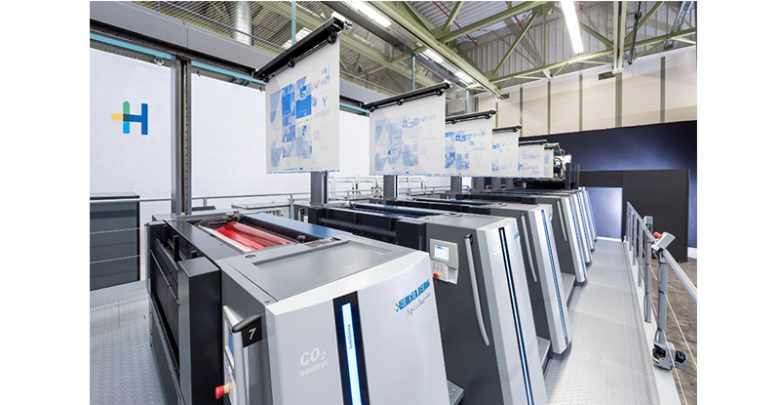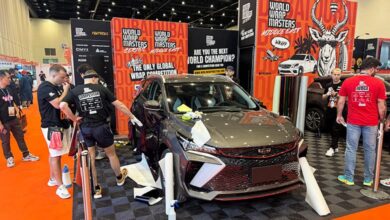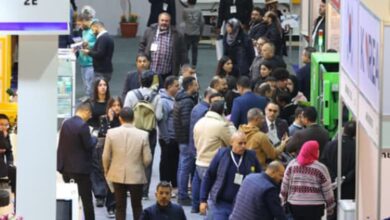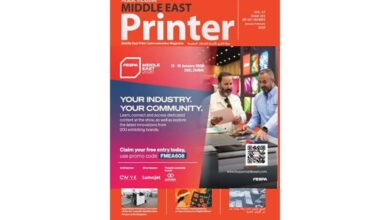Heidelberg Premiers Completely Autonomous Print Production

In mid-October, Heidelberg held a world premiere of completely autonomous production at an in-person event at the Wiesloch-Walldorf site. The digital planning system Prinect Scheduler schedules the incoming data in the optimum order based on criteria such as paper, color assignment, and folding layout. Imaging of the printing plates takes place fully automatically via the Suprasetter production line in the correct order. “Prinect knows at all times which plates are stored where. The order of the jobs in the plate storage system is optimized so that changes from job to job are kept as small as possible – we call this incremental makeready. Based on substrate parameters and job data, the anticipated paper stretch can be calculated and already compensated for during the imaging. This saves time and reduces paper waste,” explains Rainer Wolf, Head of Segment Management Commercial at Heidelberg.
The jobs are automatically loaded directly into the job memory of the printing press by the Prinect Scheduler. This includes the information about where the plate is stored. With Plate to Unit, the new and fully automatic printing plate logistics at the printing press, the printing plates are provided and removed using a fully automated process. “With industrial production of short runs, we get to ten to twenty job changes per hour in no time at all. Plate to Unit reduces the operator’s workload and ensures a reliable and stable process. Each plate has its own ID. This is how we ensure that the right plate is provided at the right time in the right printing unit. The risk of creases or scratches on the plate is eliminated. The process is more stable, downtimes are minimized, and the quality is better,” says Rainer Wolf happily.
The 2020 generation of the Speedmaster XL 106-8+P+L has everything needed to systematically harness the performance of the press. Operator navigation reaches a new level with further intelligent assistance systems and the use of artificial intelligence. The new Heidelberg UX thus delivers a new user experience and a modern workstation that provides ergonomic assistance for top performance. For example, the patented Intellistart 3 software organizes and optimizes the makeready processes. The new Intellirun software extends the navigation functionality beyond the makeready process. It provides the operator with continuous information appropriate to the situation on which activities are required to avoid unnecessary auxiliary times. For example, the Wallscreen XL switches to the job preparation menu in good time before the run is reached. The operator can review the data in good time, become familiar with the upcoming change sequence, and provide any materials not yet available. Navigation functions like these are becoming more and more important. On the Wallscreen XL, the Intelliguide timeline display ensures transparency across all processes. The operator can see exactly where manual interventions are needed. However, operator navigation is not limited to the machine control station: it is now also available at the printing units thanks to the new Intelliline. LED strips show whether the press is in production or makeready mode, and whether and if so where the operator needs to take action. With the Press Center Mobile app, control station information is also available on the go. The operator always has the job data and press status available in real time and can use it, for example, when providing materials for the next job.
To be able to head into postpress with a zero-waste pile, the waste sorting gate has been integrated in a perfecting press for the first time. The press detects waste sheets and automatically ejects them. The ejected sheets are immediately shredded and disposed of via a vacuum unit. This means there is no more collection bin to empty.
Ever shorter delivery times require that the sheets get to postpress as quickly as possible. The new generation of the DryStar LED Pro dryer systems is not only 20% lighter, it is also more powerful and ensures a dry pile in the delivery, which can go straight into postpress.
This is then sent by an unattended transport system to the Stahlfolder KH 82-P folding machine, which folds around 15,000 sheets per hour using the shingled folding principle. The KH 82-P is also integrated via the Push to Stop concept and detects the next signature automatically by the printed barcode. Each new signature is autonomously recognized and automatically started. Compared with the previous workflows, this eliminates a total of six steps as well as the factor of operator influence. “The operator moves around seven tonnes of paper in one shift on this high-performance machine – a bundle every 12 seconds. The only way we can continuously realize the full potential of the press is by significantly reducing the operator’s workload. This is why we developed an industrial robotic solution with the Stahlfolder P-Stacker, which also permits the use of Euro pallets. Most of the know-how here is in the sophisticated gripper system, which was modeled on the human hand,” explains Rainer Wolf. The folding machine operator enjoys a significant reduction in workload and gets a modern, automated, and highly productive workstation.
Another world premiere in the area of folding machines is the Stahlfolder TH 56 Pharma, which sets a new performance standard in the growth field of pharmaceuticals with extensive automation and a robust machine platform. It features many new extras that enable much more economical production of a wide range of package inserts than on most of the folding machines around nowadays that require manual adjustment.
There are also new Push to Stop solutions for cutting on the Polar cutting systems. Whereas jogging used to be a laborious manual process, the new AirGo Jog system now fully automates it.
“We speak provocatively about doubling productivity with Push to Stop – end-to-end. That is quite possible for the majority of print shops – a small number are already demonstrating this in real life, and not just the web-to-print printers, either. It’s our mission to enable our customers to unlock this potential. Because our customers’ success is ultimately our success, too,” explains Rainer Wolf.
Smart Print Shop
At the event Heidelberg also demonstrated how the Smart Print Shop is the solution for economical production and surviving increasingly tough competition for smaller and medium-sized print shops, too. “Less overtime and special shifts as well as more time to build customer loyalty, on top of this having transparency about which jobs are profitable and which are not. All of these are benefits that the Smart Print Shop provides, and that are also important for smaller businesses. Their production volumes are smaller and more varied. Accordingly they need different products that fit their budget. We have a lot to offer here, with our broad portfolio. From scalable software solutions and Push to Stop functionalities on all printing presses to corresponding solutions in postpress,” says Rainer Wolf.





